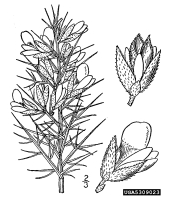Gorse
(Furze /Whin/ Ulex europaeus L)
Janene Schillier

Ulex the Latin name for a spiny shrub , europaeus for its European origin and ‘L” after the Swedish botanist Linnaeus who gave the weed its name.
Gorse originates in Portugal, Spain, France and Britain.
Gorse is a dense extremely spiny shrub up to 7 metres tall but commonly 1 to 2.5m tall
The stems are soft grey green and hairy when young, hardening with age. Bark on mature stems is rough with diagonal and lengthways pale brown and grey ridges
Gorse flowers are bright yellow and are shaped like peas or other legumes and have a coconut smell.
Seed pods are covered with fine dense hairs and contain 2 to 6 seeds, with green or brown hard seed coat.
Gorse enjoys a range of conditions and can establish on soils which are poor.
Gorse plants live for up to 30 years and plants begin flowering from 18 months
It can flower throughout the year, but in this area peaking March to May and July to October. Seed fall occurs in warm weather, when pods split open and eject seed up to 5 metres from the plant at a rate of 600 – 2120 seeds per square metre per year . This is an annual input to the soil of 6 to 21 million seeds per hectare.
The management and control of gorse is known as a difficult task, some ignoring the problem thus creating further challenges for adjoining landowners, roadways and waterways. However terrific results are achieved by knowing what to do and a vigilant progressive approach. This article aims to assist in this way with facts and tips in 4 parts.
Reference: Gouldthorpe.J (2009) Gorse National Best Practice Manual (Second Edition) Department of Primary Industries and Water Tasmania
Gorse control
Planning the attack
Walking on foot is a good way of finding where your gorse has germinated. Larger infestations or older large bushes can be seen easily without walking. We will look at planning your attack on gorse at your property and surrounds. Getting a plan is a good start with the idea of halting the seed bank as soon as possible and getting access to the area if large. There can be up to 40,000 gorse seeds or 400 million seeds per hectare under a mature gorse bush at any one time. They are mainly in the top 2.5 cm of the soil but can be down to 15cm. Establishment does not occur from more than 8cm depth.
Gorse has a wide range of impacts, from land use
reduction to fire risk as it is highly inflammable. It invades native vegetation and reduces carrying capacity significantly and prevents movement of stock. Around 10% of gorse seed in the soil germinates at a given site in a given year. Assuming no new seed input to the soil, it
would take 30 years for a typical gorse seed bank at a site to decline to 1000 seeds per square metre. If the annual germination rate increased to 50% at the same site soil seed would reduce to near zero after 10 years. 99% germination of soil seed per year at the same site would eliminate soil seed after only four years. These figures have implications for management because
some gorse control methods can increase germination above the natural 10% level. Fire may cause 50% germination in soil seed depleting the soil seed bank and turning seeds into seedlings which are then vulnerable to follow up control . (Follow up is essential once any control plan in implemented).
¨
The Plan
- Define problem areas – make a map.
- Determine priorities – easier areas, upstream
infestations, uphill & downhill areas on slopes. - Determining spread, effects on neighbours, burning hazards / seasonal considerations.
- Decide on a financial plan for each year (a lot can be done by the landholder by deciding on the attack).
- Schedule plan and stick to the follow up.
It is encouraging to see results by starting with small areas stopping the gorse from seeding is a great start.
Observation at flowering time around September / October allows you to see where the gorse is and attack the young plants before the seeds form.
Helpful website : Victorian Gorse Taskforce – podcast of Introduction to Gorse zoomed on 24 November 2020 plus other resources and strategies.
Reference: Gouldthorpe.J (2009) Gorse National Best Practice Manual (Second Edition) Department of Primary Industries and Water Tasmania
¨
Carrying out the program
Once you map out the areas requiring control, develop a program based on the type of land or infestation you need to treat and the options you have available. Before following these programs, it is important that you develop a five year gorse control plan work out your primary control, and follow up method prevent further seed spread. Various situations can include steep or stony pasture, arable pasture, native vegetation, riparian zone, stream banks, creeks, water courses or near dams)
Multiple approaches – large & smaller infestations
Once you start your plan multiple methods can be used.
For example significant infestations may be suitable for mechanical control (excavators, blades etc) followed by spraying with herbicide when it shoots.
Smaller areas might be done by spraying with herbicide (effectively kills the plant & roots if done correctly) and manual methods like cut and applying herbicide to the cut surface. The method should be decided before starting. Reading the Best Practice Guide is recommended because it discusses the successful methods for every circumstance and saves time working out best methods yourself (see Victorian Gorse Taskforce) website. Whatever is decided the investment to control gorse is wasted if follow up, monitoring and enthusiasm for results are ignored.
Stopping the seed bank can be effective in smaller areas with manual chopping with loppers to gain access, making a pile and then in suitable weather building a fire from other material such as branches, to get the fire going then systematically burn the lopped gorse. Note : this method is not available in the summer or warmer months.
Gorse is highly inflammable and poses a significant risk. Gorse seed is destroyed if heated to a hundred degrees for 20 minutes – including seeds which are on the top few centimetres of soil (if this where the heat is) Inspect for new growth and apply spray. Heat stimulates seed germination and growth of multiple stalks – a big problem if not sprayed.

Gorse will return if there is no follow up, so plan to implement your methods for 5 years at least. Planting vegetation as a competitor is not recommended until certainty of containment. Examples of planting too early has resulted in multiple problems of gorse return in amongst the new vegetation.
Thought for a yearly budget over a period of 5 years or more, combined with researching techniques and sticking to a vigilant approach will give positive results, satisfaction and encouragement.
Landholders can do a lot themselves thus reducing costs. Some may engage a contractor. A hands on approach allows you to be educated, monitor and see results over time
In summary methods are:
- Cut and apply herbicide to the cut surface (within 20 seconds).
- Herbicide spray and monitor, repeat and check at least annually.
- Use of excavator to remove plants then herbicide spray follow up.
- Doing this yourself or hiring an experienced contractor.
Young seedlings are easy to pull out by the roots in damp soil. This is a good winter job. Gorse is a difficult invasive woody weed, but with a vigilant approach, great results can be achieved. Seek assistance from the Victorian Gorse Taskforce and other websites (Tasmania)
Future management & resources
It’s now autumn. One of the objectives of gorse control and elimination is to stop the seed. Mature gorse plants can produce flowers most of the year, but characteristically Spring and Autumn produce prolific flowers in our area. These turn into millions
of seeds. The flowering stage allows you see where the gorse plants are, particularly if they are young (around 18 months) and difficult to spot due to their size. A good time to pull them out! So! It’s a good time to get stuck into this horribly invasive
woody weed and stop the seeds. Yes! Stop the seeds then follow your plan to eradicate existing
plants and extinguish new growth. The unusually wet past months, have kept the soil damp still
making it possible to dig out small plants with a mattock or tool to prise the deep root out of the
soil. Be careful to pat down the disturbed soil as this can encourage seeds to germinate. Have a go and see how many young seedlings you can pull out. Walking around now you can see the green growth of newer plants on roadsides, your own place or bushland. Carry some tools and your spray pack in your car or on foot – a bit at a time will still give results. Gorse harbours foxes, rabbits, feral cats and decreases grazing area for stock and takes over bushland. The writer of this column hopes that the content has started you on the way to doing something about gorse in your area. It is a rewarding activity, when you can see areas clear of gorse and the follow up is a routine not to be
missed. Follow up spraying or pulling out or cut and painting small plants is not a hard task – not as difficult as the decision to do something or start the process !
Good luck and happy Gorse hunting!!

References & Resources
- www.vicgorsetaskforce.com.au pipwe.tas.gov.au (pdf info file)
- Book: Weeds of National Significance – Gorse National Best Practice Manual (Australian Govt, National Gorse taskforce,DPI and Water
Tasmania - Mt Lofty Ranges u-tube – tree puller aparatus
- Broom Busters (Canadian) U Tube – another unwelcome invasive weed – “Stop the Seed” yellow flower like gorse
- The Meredith Community Centre has offered to display a few excellent brochures about gorse. If you would like to pick one up call in Mon to Thurs between 9am and 3pm 4 Russell St Meredith Ph 52 86 0700
One copy of National Best Practice Manual – Gorse – is available to peruse at the Centre
Thank you to the Centre for making gorse information available to our community.



